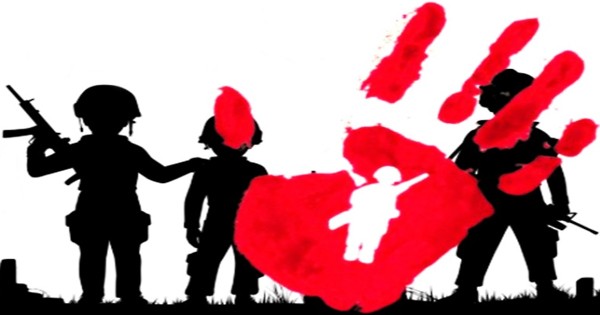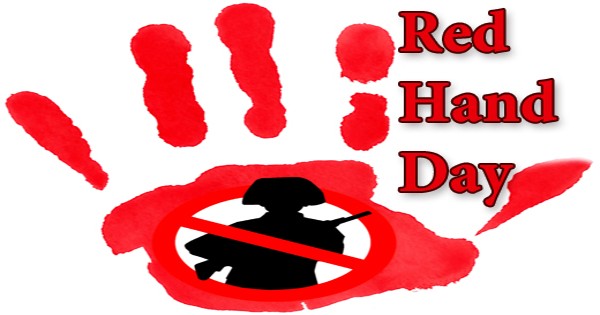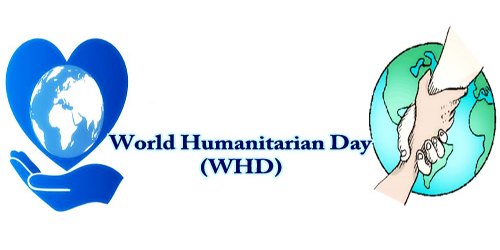Children are caught up in a variety of violent conflicts around the world. Afghanistan, Chad, Central African Republic, Colombia, Democratic Republic of Congo (DRC), India, Iraq, Israel/Palestine, Myanmar (Burma), Pakistan, Philippines, Somalia, South Sudan, Sudan, Syria, Thailand, and Yemen are only a few recent examples. Since 2002, on February 12th, Red Hand Day, or the International Day Against the Use of Child Soldiers, appeals have been made to political leaders and activities have been held around the world to raise awareness about child soldiers, who are children under the age of 18 who serve in military organizations of all kinds. The aim of Red Hand Day is to mobilize support for children who have been affected by this practice and to call for action to end it. The lives of young soldiers are often filled with dangers and are marked by hard work, a lack of food, and a lack of drinking water. There is no medical attention, just the persistent fear of being caught in an ambush, a landmine, or gunfire. Brutal tactics are used to impose discipline and obedience. As part of its global fight against the use of child soldiers, the Coalition to Stop the Use of Child Soldiers adopted the “red hand” symbol in 1998. Since the Optional Protocol to the Convention on the Rights of the Child on the involvement of children in armed conflict (the Optional Protocol to the Convention on the Rights of the Child on the involvement of children in armed conflict) came into force on February 12, 2002, Coalition partners have designated this day as “Red Hand” day, with many hosting local events to raise awareness about the child soldier problem. Thousands of children are now recognized as soldiers, porters, messengers, and other positions in armed groups all over the world. Many are kidnapped from their homes, abducted while at school, or forced to join the military. Children can enter armed groups as a result of extreme poverty, desperation, family obligations, or environmental pressures; many have no other choice. Many children die in inhumane conditions, while others spend the rest of their lives handicapped, blind, or traumatized. However, boys are not the only ones at risk. Approximately one-third of child soldiers are girls. They are required to perform the same tasks as the boys, but they are often subjected to sexual assault and are forced to serve as the commanders’ “wives” or sex slaves. As a result, many people contract HIV/AIDS or other sexually transmitted diseases, and many become pregnant. They are often stigmatized and forced to live with their babies in deplorable conditions. Although the bulk of child soldiers are between the ages of 15 and 18, 9-year-olds have been drafted in some conflicts. Other children grow up in war zones and have a slim chance of surviving if they do not “voluntarily” join one of the armed groups.

Child labor is considered the “worst form of child labor” in armed conflict, but it is also a human rights abuse, a war crime, and often a form of human trafficking. Human trafficking occurs when children are recruited through force, fraud, or intimidation and exploited to work in armed groups (for labor or sexual purposes). And this abuse has long-term, extremely negative physical and psychological consequences for children and their families. It’s difficult to determine how many children are affected due to widespread military use of children in areas where armed conflict and instability block UN officials and other third parties from entering. Child Soldiers International estimated in 2017 that tens of thousands of children, perhaps more than 100,000, were serving in state and non-state military organizations around the world, and the organization announced in 2018 that children were being used in at least 18 armed conflicts. Government armies, opposition (rebel) forces, and government-linked militias and paramilitaries all use child soldiers. Child soldiers may work as porters or cooks, guards, messengers, or spies once they’ve been recruited. Many are pressed into service, where they may be required to fight on the front lines or sent into minefields ahead of more experienced troops. Suicide missions have been carried out with the help of some youngsters. Often children are coerced to commit crimes against their own families or neighbors. Such activities continue to “stigmatize” the child and prevent him or her from returning to his or her home community. Because of their emotional and physical immaturity, children are particularly vulnerable to military recruitment. They are easily manipulated and drawn into violent situations that they are unable to avoid or comprehend. When children are released from military service, they also need assistance in reintegrating into their communities. Child soldier rehabilitation and reintegration is an important aspect of a peace process, but it is costly and involves the involvement of whole populations. Children are first and foremost children, not peasants, soldiers, or insurgents. Every child deserves an education, a voice, and the ability to succeed alongside family and friends, and every child deserves peace, protection, and security. Many children enter armed groups as a result of economic or social strain, or because they believe the group can provide them with food or protection. Others are enlisted against their will, “press-ganged,” or kidnapped by armed gangs. Communities may have a hard time accepting these former child soldiers, and the teenagers may reject group rules and customs. Since 2002, on February 12th, Red Hand Day, nations and international coalitions from around the world have held activities to raise awareness about the problem and promote action to end the use of children for military purposes. The date represents the OPAC (Optional Protocol on the Involvement of Children in Armed Conflict) treaty’s entry into force. Communities, families, and former child soldiers all need financial assistance and resources in order to re-establish social systems and create opportunities for them to rebuild their lives. UNICEF does so by supporting programs that provide for the physical and mental health of affected children, teach them life skills, and involve them in activities that promote their well-being. UNICEF takes a community-based approach to facilitating reconciliation, eliminating discrimination, and establishing mechanisms to protect and prioritize children’s rights.
















